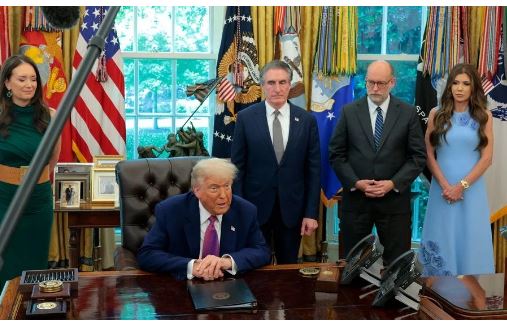Democrats Raise Concerns Over Trump’s Plan to Restructure FEMA After Hurricane Season
The Federal Emergency Management Agency (FEMA) has already faced staff reductions and leadership shifts ahead of what is expected to be an “above-normal” hurricane season.
On Tuesday, officials from the Trump administration announced plans to “eliminate FEMA as it exists today” following this year’s hurricane season. This proposal, which would shift greater disaster response and recovery responsibilities to state governments, drew criticism from congressional Democrats.
“For decades, FEMA has played a vital role in the federal response to hurricanes and other disasters, protecting people and property,” said House Homeland Security Committee ranking member Bennie Thompson (D-Miss.) and Emergency Management and Technology Subcommittee ranking member Tim Kennedy (D-N.Y.) in a joint statement. “Dismantling this essential agency would remove a crucial safety net for millions who depend on federal assistance during disasters. It is unreasonable to expect states—many of which lack adequate resources—to handle consecutive large-scale disasters on their own.”
Since the beginning of his second term, Trump has targeted FEMA, expressing a desire to “wean off” reliance on the agency.
“These governors are capable of managing disaster response. They will collaborate and assist one another,” Trump said during an Oval Office briefing on hurricane and wildfire preparedness. “FEMA has been an expensive, ineffective experiment.”
Homeland Security Secretary Kristi Noem stated that the “state-first” strategy is already shaping hurricane readiness efforts.
“We’re ensuring preparedness by pre-staging resources and working with traditionally affected regions,” Noem explained. “At the same time, we are developing communication and mutual aid agreements among states to enable them to respond independently, with federal support reserved for catastrophic situations.”
Trump also mentioned plans to reduce overall disaster funding, directing more money straight to states.
Because FEMA is established by statute, it is uncertain how much the president can change the agency’s structure without Congressional approval. Previous attempts by Trump to overhaul other government agencies have faced legal challenges.
The hurricane season, running from June 1 to November 30, is predicted by the National Oceanic and Atmospheric Administration to produce six to ten hurricanes—above average.
Though Noem claimed FEMA is ready for “higher than usual activity,” CNN reported that FEMA’s workforce has shrunk by 10% since January, with projections indicating a 30% reduction by year’s end.
The Trump administration also replaced the former acting FEMA leader, Cam Hamilton, after his Congressional testimony opposing the agency’s elimination. He was succeeded by David Richardson, who previously served as assistant secretary of DHS’ Countering Weapons of Mass Destruction Office.
A senior DHS official told Government Executive that FEMA is “fully activated” for hurricane season and is transforming “from a bloated, DC-centric organization into a lean, deployable disaster force that empowers states to support their citizens.”
The official added that old procedures are being discarded due to decades of failures during emergencies.
In March, Trump signed an executive order mandating a review of national preparedness and response policies, with recommendations for updates or replacements due by year-end. DHS has also convened a bipartisan council, co-led by Noem and Defense Secretary Pete Hegseth, to advise on proposed FEMA reforms.





